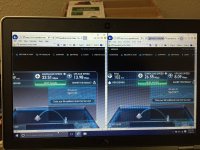esscobra
Well-known member
Firstly- rvs provide a host of connectivity issues due to their construction - have worked with several rv parks and customers on wifi-
Most of the units are only using 1- mostly sprint as with unlimited data- more remote locations att and Verizon have better service
I have a few customers using dual modems with dual providers where connectivity is critical
the newest lp6 models will pull from multiple towers/cells and get the extra speed
The cradlepoints are really designed for providing cell based data where std broadband is not- and in mobile ( police/fire/ems ) and kiosk/redbox applications - It has evolved into being a great backup/secondary wan solution for customers ho rely on cloud(web) services or poor wifi in parks-
if anyone needs pricing on cradlepoints or services/warranties pm me. I am computer support services and hardware reseller. ( not trying to advertise- just willing to help fellow memberws save $ )
- - - Updated - - -
here is pic showing difference in 1600 and 1600 lp6 speed connected wifi to 1600 on laptop
Most of the units are only using 1- mostly sprint as with unlimited data- more remote locations att and Verizon have better service
I have a few customers using dual modems with dual providers where connectivity is critical
the newest lp6 models will pull from multiple towers/cells and get the extra speed
The cradlepoints are really designed for providing cell based data where std broadband is not- and in mobile ( police/fire/ems ) and kiosk/redbox applications - It has evolved into being a great backup/secondary wan solution for customers ho rely on cloud(web) services or poor wifi in parks-
if anyone needs pricing on cradlepoints or services/warranties pm me. I am computer support services and hardware reseller. ( not trying to advertise- just willing to help fellow memberws save $ )
- - - Updated - - -
here is pic showing difference in 1600 and 1600 lp6 speed connected wifi to 1600 on laptop
Attachments
Last edited:

